Occupied Spaces
- Published
- comments
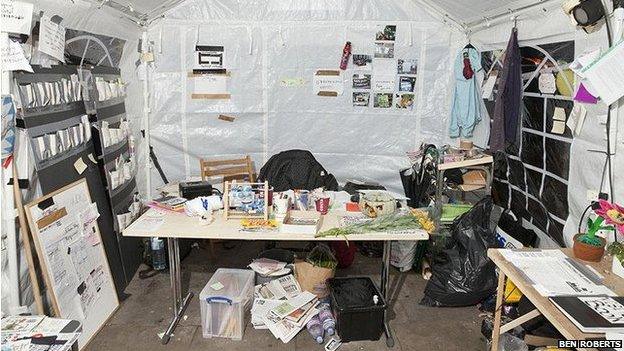
As part of the worldwide Occupy Movement, external protesters have been camped outside St Paul's Cathedral in London since 15 October looking to highlight economic inequality, social injustice, corporate greed, and the lack of transparency and accountability in the City.
Initially the group had wanted to occupy the area outside the London Stock Exchange which sits alongside the Cathedral, but the police stopped that from happening and so the Occupy London Stock Exchange (OLSX) protesters then turned to St Paul's Churchyard, the square in front of the cathedral, planning to set up camp.
The camp now stands at around 200 tents and has attracted many photographers, from those working for the news wire agencies through to students of the medium.
Photographer Ben Roberts decided to join those documenting the camp but rather than picturing the residents he took a slightly different approach to the majority of the others working there.
"I had the idea to photograph the tent interiors while taking a train down to Lymington last Wednesday to do an assignment for the Guardian," Ben told me. "I'd found the 'thermal imaging, external' stories in the right wing press a little far fetched, so felt really motivated to make a photographic reaction to this."
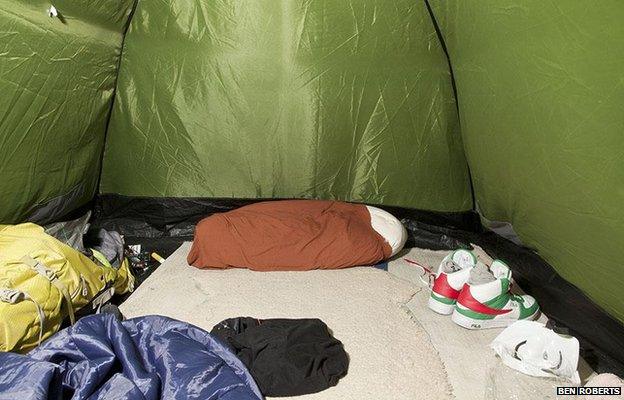
Ben continues: "I've become more politically motivated as I've got older but this is the first time that I have felt really energised to go out and make images as an immediate response to something so current. Like lots of other photographers and artists, I daydream project ideas; many of them get jotted down in rough note form, but then get shelved for lots of different reasons. Time, money, a feeling that the concept isn't quite right - all of these are explanations for the why some project ideas never get off the ground."
This time around though Ben's main worry was that someone would have already had the idea and he'd be too late. The main issue was gaining access to people's private space and ensuring they understood the motivation behind the work.
A meeting with Naomi Colvin and Peter Vaughn of the Occupy London, external media team went well and gave Ben a legitimacy of sorts, he told me that, "it meant that I was on the front foot when it came to the ideological and theoretical discussions that were sometimes needed to convince sceptical protesters. Some people just 'got it' straight away - others needed more detailed explanations. Some protesters had no interest at all in getting involved."
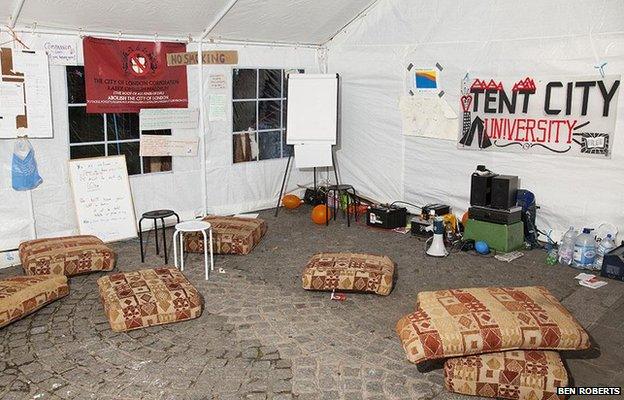
Lectures by both camp residents and visiting speakers are held on site
"I hope that the images give some sense of the experience of an occupation based protest - far from their being a surplus of empty tents for protesters, I found that space was at a premium in every corner of the St Paul's camp; the canteen, information and university tents were overcrowded with occupiers, passers by and volunteers," said Ben.
"Tent's were shared by up to 15 people overnight in some instances; the logistics of handling huge amounts of raw materials was also a constant challenge - I think this can be seen in some of the photographs of communal spaces. In spite of the somewhat chaotic nature of some of the photographs, the build up of literature, donated items and general human detritus was being admirably well managed.
"I've been on plenty of camping trips, sometimes for weeks at a time so I know that the interiors of tents take on a life of their own when they are occupied long term, so I was hoping that by removing all of the people from the scenes, more intimate narratives about the occupiers would be highlighted."
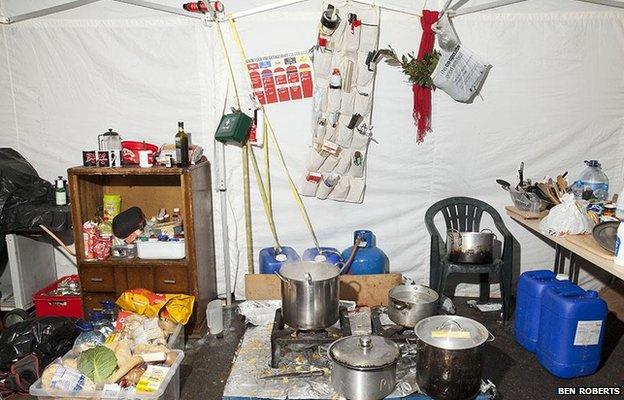
"It was the communal spaces that for me really brought life and vibrancy to both the camp and my photographs," Ben added. "If you pop by and socialise at the St Paul's Camp, you will be made welcome so long as you are open to civilised debate. In the cafe tent, the library and the university tent, there is an atmosphere of problem solving, networking and the generation of ideas. I think this is reflected in the detritus that is scattered through some of these tents - the newspaper clippings, the hand written notes, and the painstakingly constructed filing systems for incoming letters and donations.
"As you can imagine, a site of around 250 tents with many hundreds of diverse inhabitants can feel at times just slightly anarchic! I feel that the slightly chaotic nature of the communal spaces mirrors the energy and uncertain future of the occupation."
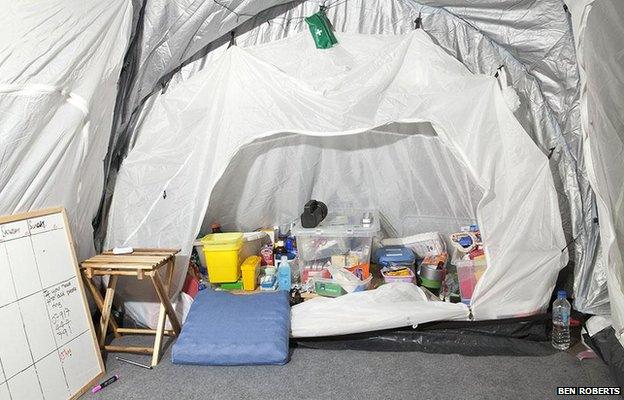
The First Aid tent
Ben continued: "I wanted my photographs to counter the rumour that the camp was unoccupied, but I'm also aware that the nature of the images means that they are open to interpretation. Some people will see the energy and commitment that I have talked about, others won't.
"Ultimately, I didn't see any point in making photographs at the camp if I couldn't add anything new to the standard photographic language that we see repeated again and again at protests. I'm convinced that photography can continue to be a powerful documentary medium, but sometimes it takes a more leftfield approach to shine a light on broader issues and to catch people's attention. I didn't want to photograph confrontations between police and protesters or the contrast in style between a banker's suit and a protester's dreadlocks. These photographs get taken (and published) again and again and tell us nothing new."
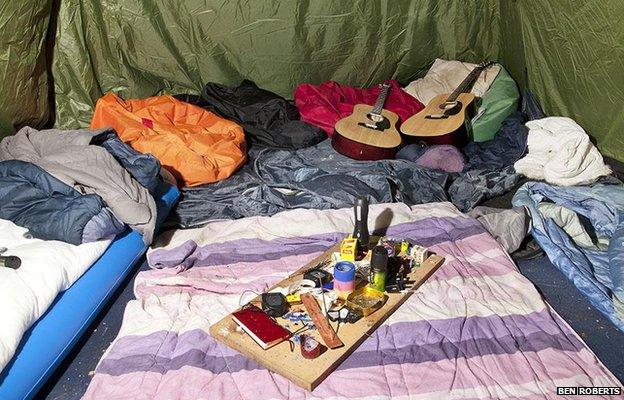
The Peace Tent is occupied by up to 15 people on any one night
"I hope that by exposing the traces of humanity in these 'Occupied Spaces', I can allow the viewer an insight into the pressures and experiences of living in a temporary community."
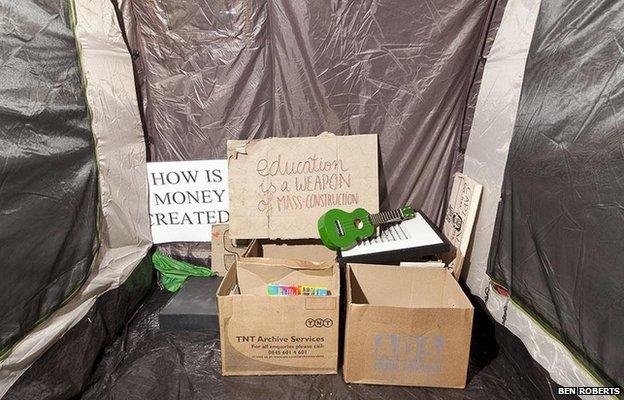
The library is running on donated books from volunteers and supporters
You can see more of Ben's work on his website, external.